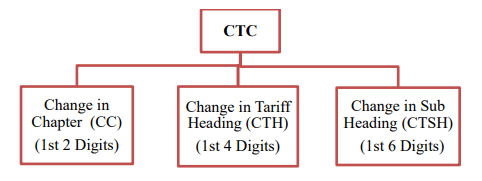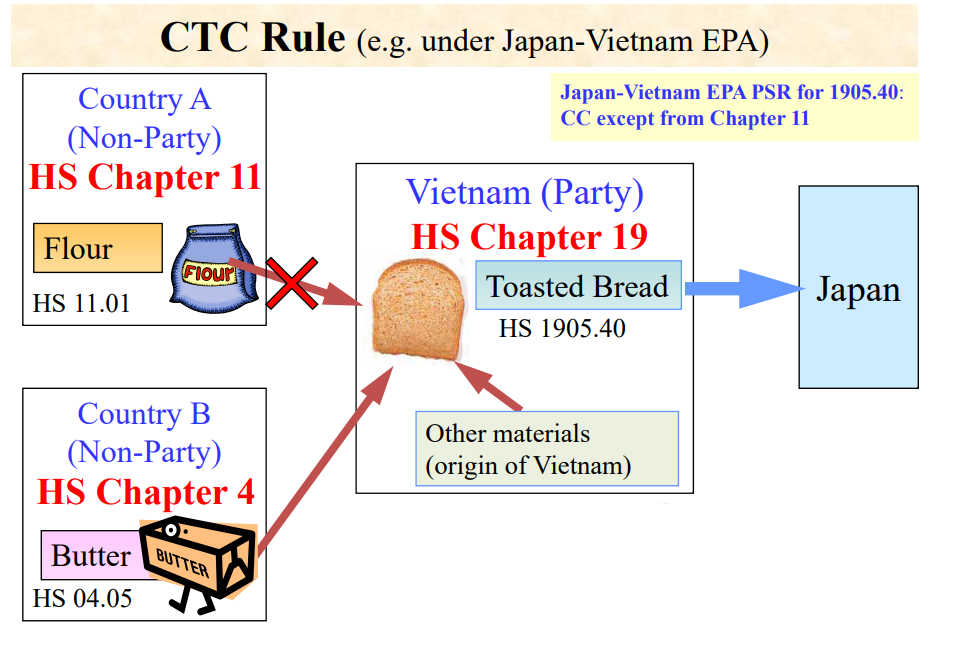When the HS code of a good differs from all HS codes of non-originating materials,
the good is qualified as an originating good.
This method is called “Change in tariff classification criterion(CTC)”

Retrieved from: Outline of Rules of Origin for EPA in Japan
Table of Contents
Harmonized System(HS)
Before explaining “Change in tariff classification criterion(CTC)”,
basic knowledge of Harmonized System(HS) is needed.
The Harmonized Commodity Description and Coding System, generally referred to as “Harmonized System” or simply “HS“ is a multipurpose international product nomenclature developed under the auspices of the World Customs Organization (WCO), an independent intergovernmental body.
The tariff schedule containing the headings, subheadings and the corresponding number codes, the notes to the Sections, of the Chapters and the Subheadings, as well as the General Rules for the interpretation of the HS.
THE HS CONTAINS
〇21 SECTIONS
〇96 CHAPTERS
〇1.200 HEADINGS
〇5,000 six figure groups called Subheadings
〇124 CONTRACTING PARTIES AND ONE CUSTOMS UNION.
〇202 COUNTRIES USE THEIR TARIFF SCHEDULE.
GOVERNMENTS USE HS FOR:
〇Exchange of trade data.
〇Establish duties and other taxes.
〇Control of regulated substances.
〇Development of Rules of Origin.
〇Preparation of statistics.
〇Price and quota controls.
〇Economic research and analysis.
All the HS codes can be searched from the WCO webpage.
All countries must classify the same substance under the same Subheading
〇Chapter (2Digits)
〇Heading (4Digits)
〇Subheading (6Digits)

Retrieved from:Identifying: World Customs Organization (WCO) Harmonized Codes
“Change in tariff classification criterion(CTC)” method is applicable only to non-originating materials. To qualify under this origin criterion, non-originating materials that are used in the production of the good must not have
the same HS classification (e.g. Chapter level, Heading level or Sub Heading Level) as the final good.

Retrieved from:Identifying:Handbook on Rules of Origin for Preferential Certificates of Origin
Depending on the Free Trade Agreement (FTA) requirements, the good would
have to undergo either a change in Chapter, Heading or Sub Heading level in order to qualify
for preferential treatment under the FTA.
Therefore, to use this method, manufacturers and/or exporters are required to know the HS
classification of the final good and the non-originating raw materials.
Product-Specific Rules (PSR)
Even if the materials from third countries (non-originating materials) are used in the production, goods
are considered as originating when the goods satisfy the requirement set out in the product-specific rules (PSR).
PSR is generally provided as an annex to each EPA.
In most of the EPAs, PSR is stipulated in the form of either: “change in tariff classification”,
“qualifying/regional value content”, “specific manufacturing or processing”, or a combination of these.
Here is an example of PSR stipulated in the Annex to EPA.

If the materials from third countries (non-originating materials) are used in the production,
Usually, we need to check PSR stipulated in the Annex to EPA.
How to read Product-Specific Rules(PSR)
e.g. under Japan-Thailand EPA
In this situation, we need to check if a toasted bread can be qualified as an originating
good of Thailand Under Japan-Thailand EPA.

Retrieved from: Outline of Rules of Origin for EPA in Japan
It looks like the toasted bread is Thailand origin, but found out that the materials
from third countries (non-originating materials) are used in the production.

Retrieved from: Outline of Rules of Origin for EPA in Japan
The Flour and Butter are non-originating since they are imported from Non-Parties to Japan-Thailand EPA

The Toasted Bread is classified under 1905.40 while the Flour is classified
under chapters 11 and The Butter is classified under chapters 04 respectively.
The Toasted Bread is an originating good under Japan-Thailand EPA because
a change from chapters 11 and 04 to chapter 19 has occurred.
e.g. Japan-Vietnam EPA
Example of under Japan-Thailand EPA The Toasted Bread is considered as an originating good.
Here is another example of Japan-Vietnam EPA.
Even the same production, The Toasted Bread is not considered as an originating good under Japan-Vietnam EPA,
because “PSR of Japan-Vietnam EPA” is different from “PSR of Japan-Thailand EPA”.
Here is PSR of Japan-Vietnam EPA (Annex 2)

PSR for toasted bread is “CC except from Chapter 11” of CTC rule (require Chapter in Change).
In this production Flour (HS Chapter 11) is used as a non-originating material.
It does not satisfy the PSR.

Without applicable exceptions to the substantial transformation criterion
toasted bread can not be qualified as an originating good of Vietnam.
e.g. under Japan-Singapore EPA
Good: Strawberries Jam (HS 2007.99)

PSR: A Change to heading 20.07 from any other Chapter (CC).
The strawberries jam is classified under chapter 20 while the strawberries
fruit and sugar are classified under chapters 08 and 17 respectively. The strawberries fruit
and sugar are non-originating since they are imported from Korea and Australia
respectively (Non-Parties to JSEPA). The strawberries jam is an originating good under
JSEPA because a change from chapters 08 and 17 to chapter 20 has occurred.
e.g. under Korea-Singapore EPA
Good: Crocodile Leather Handbag (HS 4202.21)

PSR:A Change to heading 42.01 through 42.03 from any other Heading (CTH).
The crocodile leather (HS Heading 41.15) is a non-originating material as it
is imported from Indonesia, a non-Party to KSFTA. The leather handbag is an originating
good under KSFTA because a change from HS Heading 41.15 to HS Heading 42.02 has
occurred.
e.g. under Japan-Thailand EPA
Good: soya sauce (HS 21.03)

PSR: Change of heading (change in the first 4 digits of the HS)(CTH)
The Soya beans (HS Heading 12.01) is a non-originating material as it
is imported from USA, a non-Party to Japan-Thailand EPA. The Soya sauce is an originating
good under Japan-Thailand EPA because a change from HS Heading 12.01 to
HS Heading 21.03 has occurred.
Here is an example of an item which does not satisfy the ROO in CTC case
In the case of not fulfilling the CTC rule
